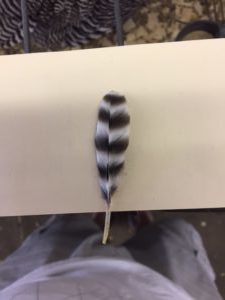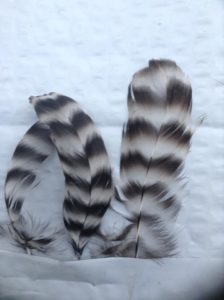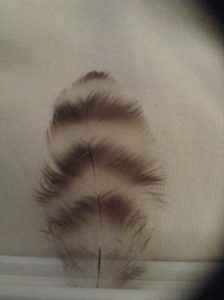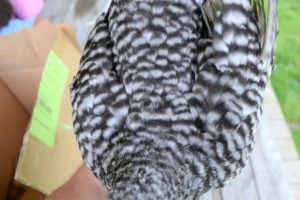
Melody Hobbs wrote: Over the years I’ve seen quotes taken from old texts where Dominiques were described as a “hawk colored fowl”. I’ve also seen plenty of people discount that description by saying the author was *really* describing a grey game fowl or some other pattern. I never thought much about it, but this evening, looking through the winners of the 2013 Natural History Museum’s wildlife photographer of the year contest, I had a real “Ah ha!” moment.

The feather pattern for the Dominique is known as “cuckoo”. In the earliest poultry literature we see this term used to describe barred varieties of fowl. In fact, “barred” comes into the vocabulary much later. The term cuckoo was used due to similarity of the barring seen in the wild cuckoo.
The American Poultry Association defines cuckoo as “A term applied to the coarse and irregular type of barring found in Dominiques, Barred Hollands and Cuckoo Belgian Bearded d’Anvers Bantams. See Barring.”
In the glossary they then define barring as “Alternate transverse markings of two distinct colors on a feather, regular in shape as in Barred Plymouth Rocks, irregular in Dominiques, Hollands and Cuckoo Belgian d’Anvers Bantams.”
The Standard further defines the Dominique plumage as slate, feathers in all sections of fowl crossed throughout their entire length by irregular dark and light bars that stop short of positive black and white; tip of each feather, dark; free from shafting, brownish tinge or metallic sheen; excellence to be determined by distinct contrasts.
And here the definition stops. Unlike some other breeds no pictures were included in the Standard of Perfection to show the ideal feathers for the Dominique breed. This leaves the breeders to make their interpretation of the above descriptions regarding the cuckoo pattern.
The cuckoo pattern is considerably more complex than one would think. There are multiple issues involved from the pattern on the feather itself to how the feathers layer to enhance that pattern.
One issue should be eliminated out of hand. The Standard is specific that distinct contrast is required within the Dominique cuckoo pattern, however that does not necessarily mean a sharp contrast of color, it means there is a clear break between the dark bar and the light bar. Refer to the page on feather color for a more in-depth discussion of color.


Let’s start by looking at a sample of feathers from a Dominique bantam – though bantam or large fowl should not matter – the discussion applies equally to both. At first glance one would think these feathers came from a Barred Plymouth Rock but look closely. Notice the white and black bars are not equal in size nor are they exactly parallel.
While the feathers are significantly more uniform than I would prefer, look at the hen. Because of how the individual feathers lay, the barring does not line up and form rings around the bird like you see in Plymouth Rocks. In this case those somewhat “uniform” barred feathers result in a very pleasing pattern on the chicken.


Here is an example of what occurs when the feathers are a little “cuckoo” and “not perfectly barred” but the bars line up. This is actually a nicely patterned Barred Plymouth Rock Bantam cock. The pattern on the bird is enhanced by the light and dark bars lining up to form rings around the body. This sample underscores the fact that there are several factors at work to make good cuckoo.
In both of these cases the distinct break between the colored bars results in a nice pattern. However there are far too many Dominiques shown with blurry or smutty barring. This dark smudge in the light destroys the cuckoo pattern. Here is an example of a hen with very poor color contrast.
In the early days of the Dominique Club of America Roger Voter wrote on the “V” that the feathers should have to accomplish the desired cuckoo pattern. When this trait was discussed some questioned if it still existed. Fanciers were surprised to see that the erratic cuckoo pattern and the V existed in their flock.





There is a temptation to believe that the left side of the feather quill should mirror the right side. This is not the case. As Roger Voter pointed out in the Dominique Club of America newsletter there are several acceptable cuckoo patterns. Here is a sample feather that Melody Hobbs found from one of her birds.

I think the “V” discussions from the past have lead to thoughts in the current time that is different. I can tell from the recent discussions that the V is a sharp narrow V whereas in the past we thought move of an open U. Look at the pictures of the feathers on page 188 of my book “Pictures of modern feathers. These are female body feathers. Look at the Hyman/Uber feathers they most clearly show the open V. This pattern is what gave the “eyes” to the end of the feathers when the body of the bird was viewed from the side. We suspect Carter’s birds also carried this and Schilling captured it on the surface of this birds.


Here we see examples of John Hyrcek, Jr’s stock. The hen from 2014 shows a nice clean crisp, open barring. The pullet on the right is from 2017 and we look forward to seeing how she develops. As you can see, we do have breeders working on maintaining a nice clean cuckoo pattern.

Now that there are fewer “old style” breeders around some of these finer points have faded away. It’s rare that we see barring such as shown in the accompanying USDA feather plate. I’m not sure the traits are lost, maybe these recessive patterns are just are buried deep again. I hope we see our members efforts pay-off bringing back an attractive cuckoo pattern.

Look closely at the feathers on this Stetson. Those are Dominique and Nankin bantam feathers. The Dominiques are from the old Hyman hen that I received from Colonial Williamsburg. It clearly shows the lacing that the old timers wanted.
One of the problems I struggle with is not knowing exactly how to replicate the desired cuckoo pattern. What few genetics works address the topic of barring give us no specifics on how to breed the desired pattern. We are left with the age old issue of raising enough young birds to produce the result we desire – not a very scientific approach. I continue to seek wisdom on this matter.
In 2017 I had the opportunity to talk barring with a Master Breeder of Old English Game Bantams and he gave me a lesson on improving the pattern on the body of the bird. Apparently this is well known in the Old English, Sebright and Partridge Wyandotte people – the place to watch for the clarity of barring is the hocks! Yes, you got that right, they watch that area for good lacing/barring etc and if you get that right the rest will follow. This is in keeping with a lesson I was given on Spangled Hamburgs over 20 years ago. Cliff Ikenberry told me the same thing. I didn’t realize till the discussion yesterday that it applies to most patterned birds.